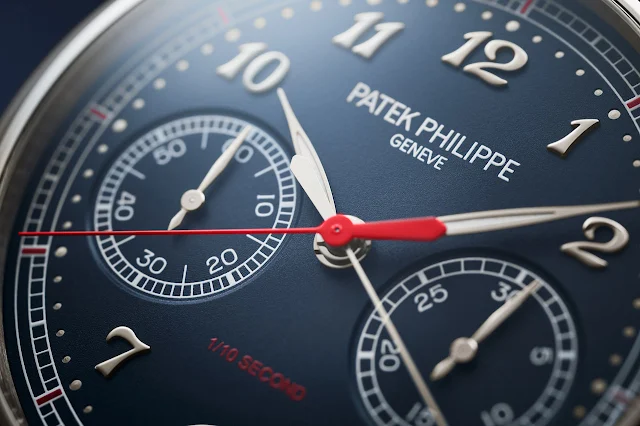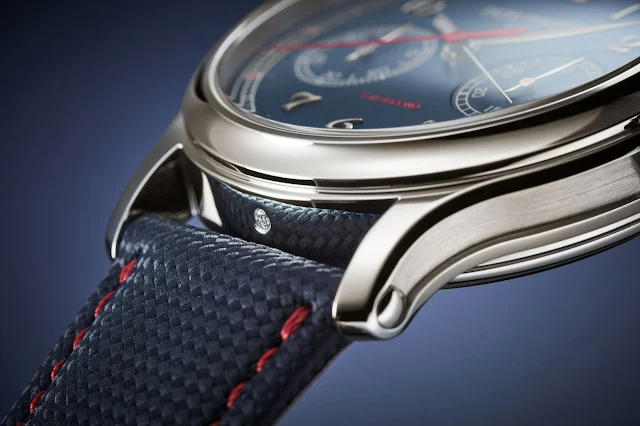Patek Philippe unveiled today the new Ref.5470P-001 1/10th Second Monopusher Chronograph. Price is CHF 380,000. Video and technical insight
The model is equipped with the new caliber CH 29- 535 PS 1/10, a high-frequency (5 Hz) hand-wound movement with two separate chronograph mechanisms and sweep hands, one of them indicating tenths of a second.
For developing it, Patek Philippe engineers relied on one of the in-house movements that had been developed during the past twenty years and, in particular, the caliber CH 29-535 PS launched in 2009 with its traditional architecture (manually wound, column-wheel control, horizontal wheel clutch) enhanced with six patented innovations and complemented by its split-seconds version with two sweep chronograph hands (CHR 29-535 PS).
The first task was to increase the frequency of the movement. With a frequency of 4 Hz (28,800 vibrations per hour that let the movement and the chronograph hands execute 8 jumps per second), the caliber CH 29-535 PS could only measure eights of a second. Therefore, the new caliber CH 29- 535 PS 1/10 beats at a frequency of 5 Hz (36,000 vibrations per hour for 10 jumps per second) making it possible to measure a tenth of a second.
In order to display tenths of a second with the desired accuracy and legibility, the designers decided to provide the movement with two independent chronograph mechanisms: one for the seconds and the instantaneous 30-minute counter, the other exclusively for measuring and displaying stopped tenths of a second.
The new patented system displays the measured seconds and the fractions of a second concentrically. The watch features two sweep chronograph hands, each of them driven by an independent mechanism. The rhodiumed hand that performs a complete revolution per minute shows the stopped seconds in the traditional manner.
The lacquered red hand performs one revolution per 12 seconds, i.e. five times faster than an ordinary chronograph hand and sweeps across 12 sectors subdivided into tenths.
In this way, the user can immediately read the elapsed seconds guided by the pearl markers and then, on the outer railway track scale, read the number of elapsed tenths of a second departing from the last red marker.
The minutes of the short-time measurement are displayed by the instantaneous 30-minute counter on the subsidiary dial at 3 o'clock.
Despite the two chronograph mechanisms and a total of 396 parts, the new caliber CH 29-535 PS 1/10 retains the diameter of the base caliber (29.6 mm) only requiring a slight height increase (from 5.35 mm to 6.96 mm).
For the frequency of 5 Hz and the integration of a second chronograph mechanism with a high-speed hand, the new caliber requires considerably more energy. To master and limit the energy demand, the engineers had to rework the mainspring and increase its efficiency to preserve the amplitude of the balance spring as much as possible and to assure optimized rate stability. To increase the available energy and boost the power reserve, the diameter of the barrel arbor was reduced and the number of mainspring coils increased. A patented notch reduces the tension of the slip bridle during the winding process, thus eliminating the risk of damage due to the increased force.
To combine efficiency, reliability, and rate accuracy, Patek Philippe used its Oscillomax ensemble developed by the “Patek Philippe Advanced Research” department. The ensemble operates with a Spiromax balance spring with a patented terminal curve and an inner boss, a Pulsomax escapement consisting of a lever and escape wheel with extensively reworked geometries as well as a Gyromax balance in Silinvar with gold inlays. Thanks to these high-end components, the new caliber CH 29-535 PS 1/10 movement achieves a remarkable high rate accuracy with a maximum deviation of -3/+2 seconds per day despite the clearly higher energy consumption of the movement.
To ensure that the two chronograph displays are perfectly synchronized, Patek Philippe introduced a patented anti-backlash principle making the teeth of the driving wheel exert an elastic force on the clutch wheel, eliminating any risk of hand vibration.
As soon as the chronograph is started, the tenth-of-a-second driving wheel (with one revolution per minute) engages with the tenth-of-a-second pinion that performs one revolution in 12 seconds (turning five times faster). To enable this “acceleration”, Patek Philippe provided the tenth-of-a-second pinion with microtoothing: 136 teeth on a pinion diameter of 1.469 mm and with a tooth height of 30 μm. The pretensioning force exerted by the clutch wheel on the pinion suppresses tooth backlash.
To absorbe shocks that could damage the mechanisms or affect performances, two patented mechanisms have been integrated. The first is a shock absorber hook securing the clutch rocker during the entire short-time measurement process.
The second one uses the “unbalances” (centers of gravity, not to be confused with centers of rotation) of components of the mechanism for the tenths-of-a-second chronograph. In the event of a shock, the acceleration values of the components exposed to it are compensated instead of being cumulated. This way, all components remain in their correct positions.
The new Ref. 5470P-001 comes in a 41 mm x 13.7 mm case crafted from platinum 950 characterised by its single pusher at 2 o'clock that successively executes the start, stop, and reset chronograph commands. Its design is inspired to the Ref. 5370 Split Seconds Chronograph launched in 2015.
The case flanks are slightly recessed and satin-finished, the lugs are subtly curved and feature decorative cabochons at the ends of the spring bars. Like all of Patek Philippe’s platinum models, the Ref. 5470P-001 is adorned with a brilliant-cut diamond between the lugs at 6 o'clock.
The concave bezel frames the elegant blue of the dial which makes all the indications clearly stand out. The chronograph seconds are indicated with a sandblasted and rhodiumed steel hand on a minute scale with small gold pearls. The tenths of a second are displayed with a slender hand in Silinvar which, thanks to its lightness, contributes to save energy while still offering the rigidity needed to withstand the shock that occurs when the chronograph is stopped. When the chronograph is not operating, the red and gray chronograph hands are superposed and look like a single hand.
Thanks to a new patented process for decorating the Silinvar hand, in this case lacquered red, and a second patent concerning the attachment of the pipe to the Silinvar hand by brazing, Patek Philippe was able, for the first time, to use this high-tech material for an external feature of the watch.
The sapphire-crystal case back (interchangeable with the solid platinum back delivered with the watch) showcases the exceptional finishes of the caliber CH 29-535 PS 1/10 including bridges with chamfered and polished edges, and Geneva striping. The engraved, gilt inscriptions “Oscillomax 5 Hz” and “GyromaxSi” on the bridges refer to some of their innovative movement components. The autonomy is 48 hours with the chronograph switched off.
Overall, this model combines 31 patents, of which seven new patents are specific to the new mechanism.
The watch is water resistant up to a pressure of 3 bar (approximately 30 metres / 100 feet) and matched to a navy blue calfskin strap with an embossed fabric pattern and red decorative seams and secured to the wrist by a fold-over clasp in 950 platinum.
The price of the new Patek Philippe Ref. 5470P-001 1/10th Second Monopusher Chronograph is CHF 380,000. patek.com





























The watch is impressive ut the price is nearly the same of my house! Imagine wearing that in a big town. I would feel a bit at risk.
ReplyDeleteIn a big town you are definitely more at risk wearing a Rolex Daytona than this. This is for tue experts.
Delete